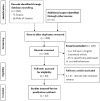Suicidal Behaviours During Covid-19 Pandemic: A Review
- PMID: 35601250
- PMCID: PMC9112993
- DOI: 10.36131/cnfioritieditore20220202
Suicidal Behaviours During Covid-19 Pandemic: A Review
Abstract
Objective: Novel COVID-19 disease has become a major concern worldwide, and a recent line of research warned that the context of the COVID-19 pandemic may be a major risk factor for developing severe suicidal behaviors. A broad systematic review is needed to cover the studies that have already assessed the potential underlying factors for suicidal behaviors in the context of the COVID-19 outbreak.
Method: A total of 52 studies met the inclusion criteria, and data were then described according to the subsequent categories: (1) countries where the studies were carried out; (2) factors impacting suicidal behaviors during the COVID-19 outbreak; and (3) examination of the observed populations.
Results: Findings of the current systematic review suggest that there is a certain amount of heterogeneity in factors impacting suicidal behaviors during the COVID-19 outbreak, with economic downturn, psychiatric vulnerability, isolation and quarantine, health concerns, and relational difficulties being the most prominent reasons for developing suicidal behaviors during the COVID-19 outbreak.
Conclusions: Timely interventions are needed to prevent suicidal behaviors in both the clinical and general populations, and in this regard, the creation of standard procedures may speed up the process.
Keywords: COVID-19; coronavirus; pandemic; suicidal behaviors.
© 2022 Giovanni Fioriti Editore s.r.l.
Conflict of interest statement
Competing interests: None.
Figures
Similar articles
-
[Suicidal behavior in light of COVID-19 outbreak: Clinical challenges and treatment perspectives].Encephale. 2020 Jun;46(3S):S66-S72. doi: 10.1016/j.encep.2020.05.001. Epub 2020 May 8. Encephale. 2020. PMID: 32471707 Free PMC article. Review. French.
-
The relationships between stress, stress-coping behaviors, and suicidal risk among Thais who had become unemployed due to the COVID-19 pandemic: A cross-sectional study.Belitung Nurs J. 2022 Oct 21;8(5):446-452. doi: 10.33546/bnj.2193. eCollection 2022. Belitung Nurs J. 2022. PMID: 37554486 Free PMC article.
-
Suicidal and aggressive behavior among populations within institutional quarantine and isolation centers of COVID-19 in eastern Ethiopia: A cross-sectional study.PLoS One. 2023 Jun 27;18(6):e0287632. doi: 10.1371/journal.pone.0287632. eCollection 2023. PLoS One. 2023. PMID: 37368902 Free PMC article.
-
Systematic review of the impact of the COVID-19 pandemic on suicidal behaviour amongst health and social care workers across the world.J Affect Disord Rep. 2021 Dec;6:100271. doi: 10.1016/j.jadr.2021.100271. Epub 2021 Nov 17. J Affect Disord Rep. 2021. PMID: 34841385 Free PMC article.
-
Global trends of suicidal thought, suicidal ideation, and self-harm during COVID-19 pandemic: a systematic review.Egypt J Forensic Sci. 2022;12(1):28. doi: 10.1186/s41935-022-00286-2. Epub 2022 Jun 4. Egypt J Forensic Sci. 2022. PMID: 35693349 Free PMC article. Review.
Cited by
-
Barriers and risk factors associated with non-treatment-seeking for suicidality onset during the COVID-19 pandemic among young adults.Psychiatry Res. 2024 Oct;340:116095. doi: 10.1016/j.psychres.2024.116095. Epub 2024 Jul 23. Psychiatry Res. 2024. PMID: 39111234
-
The Role of COVID-19-Associated Fear, Stress and Level of Social Support in Development of Suicidality in Patients Diagnosed with Affective and Stress-Induced Psychiatric Disorders during the COVID-19 Pandemic-A Comparative Analysis.Brain Sci. 2023 May 17;13(5):812. doi: 10.3390/brainsci13050812. Brain Sci. 2023. PMID: 37239284 Free PMC article.
-
Hair cortisol level might be indicative for a 3PM approach towards suicide risk assessment in depression: comparative analysis of mentally stable and depressed individuals versus individuals after completing suicide.EPMA J. 2022 Aug 30;13(3):383-395. doi: 10.1007/s13167-022-00296-z. eCollection 2022 Sep. EPMA J. 2022. PMID: 36061827 Free PMC article.
-
The Use of Photoplethysmography in the Assessment of Mental Health: Scoping Review.JMIR Ment Health. 2023 May 29;10:e40163. doi: 10.2196/40163. JMIR Ment Health. 2023. PMID: 37247209 Free PMC article.
-
Prevalence and factors associated with smartphone addiction among nursing postgraduates during the COVID-19 pandemic: a multilevel study from China's mainland.BMC Psychiatry. 2023 Dec 6;23(1):915. doi: 10.1186/s12888-023-05369-5. BMC Psychiatry. 2023. PMID: 38057732 Free PMC article.
References
-
- Abbiati, F.A., Soraci, P., Lagattolla, F., Parente, G., de Pace, R. (2020). COVID-19-A short-review of the pandemic’s mental health impact, personality traits, economics, eating disorder, homeless and education, Psychology Hub, 37(2), 41–46. doi:10.13133/2724-2943/17162 - DOI
-
- Ambrosetti, J., Macheret, L., Folliet, A., Wullschleger, A., Amerio, A., Aguglia, A., … Costanza, A. (2021). Impact of the COVID-19 Pandemic on Psychiatric Admissions to a Large Swiss Emergency Department: An Observational Study. International Journal of Environmental Research and Public Health, 18(3), 1174. doi:10.3390/ijerph18031174 - DOI - PMC - PubMed
LinkOut - more resources
Full Text Sources
Miscellaneous

